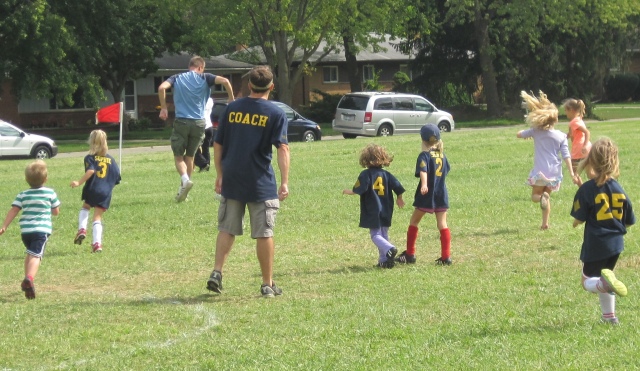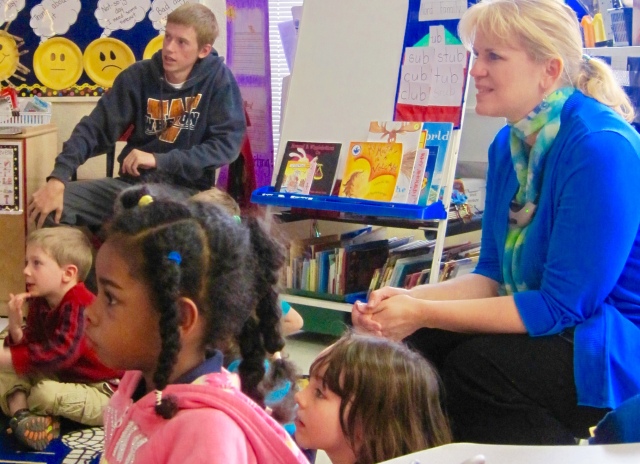Much has been written on the importance of buying local. From shopping at farmers markets to joining local farm share programs to buying “a quarter” of a nearby cow, we are learning to buy our food from producers within a certain mile radius of our homes. This is major progress for both our diets and our society.
I want to encourage us to not only buy local, but also to live local. Imagine confining our weekly activities to within a five mile radius of our homes. My philosophy is that the more often we do something, the closer to our homes it should be.
For instance, recreation. Why do the traveling hockey league when you can do the local park and rec league? We adore our town soccer program. Not only do our kids get to play with their classmates and get coached by their friends’ parents, they practice at their own school. And when it’s not at their school, it’s at a park they can ride their bikes to. Since the games are all in our town, the farthest we have to drive is a few miles. We do not spend our weekends driving all over the state so that our kids can play against strangers.

I exercise at the YMCA where I am sure to see people I know. I hear murmurs of local goings-on in the locker room, and can discuss the fourth grade homework load with another parent while I stretch. I bump into my pilates instructor at the post office.
And let’s talk about church. Rather than commuting to the “best” church forty minutes from your house, try the one down the block. Or at least the one in your own town. Why? There are a number of reasons that this is wise, and the foremost one is relationships. You will be more deeply rooted in your church community if you can bump into others from it during the rest of the week. Imagine seeing people from your small group in the midst of your weekly rounds to the grocery store, the coffee shop, the school. And how much more likely are you to get up and go on a blah Sunday morning if you only have to walk around the corner? Further, it is far more difficult to bail out on your church if you know you are going to run into fellow members who ask where you’ve been.
Your kids’ school is another choice where keeping it local is ideal. We all want the best school for our kids – the safest, the highest ranking, the most nurturing, the most inspiring educational philosophy. I think how close it is to your home should be heavily weighted as you measure “best.” One of the things that makes my girls’ school both safe and nurturing is that it is one block from my house. Not only does this mean that I can keep an eye on recess if I want, but also that it is embedded in a network of long relationships between families. What could be safer than a place surrounded by alert, watching moms who talk to each other? The more families who know one another — from dads to moms to eldest children to youngest children — the less likely a child is to slip through the cracks or bad behavior to go unnoticed. (“Mom, Ethan told me she saw Annie trying to light a match on the playground at recess.” “Annie, come down here this minute!”)
While the education offered around the block may not be Montessori or Waldorf, it does have the virtue of occurring inside a strong web of relationships. Repeated, intergenerational interactions can help keep our kids on the rails. That type of interaction easily occurs in neighborhood schools where families plant themselves for many years.

You may not have a choice where you work, but you do have a choice where you live. Why not choose a home that is in the same town as your workplace? For me, ease of commute and webs of relationships will always trump attached garages and walk-in closets.
I didn’t read the book, but I’m guessing that the reason Americans are all bowling alone is because we have made tons of choices that lead to anonymity. We drive our kids to school two towns over then drive to work in a third town. We attend church 25 miles from our house after spending Saturday 150 miles away at a soccer tournament. We shop at large, generic stores, and we exercise at chain gyms that give back little to the community.
Not only is life too short to spend in the car, it is also too short to spend among strangers. From barber shops to baristas, from diners to dentists, from hardware stores to hockey leagues, go local. You will save money and gain relationships. You will put less strain on the earth, your car, and even your health. Despite what our cars, planes, and Skype imply, we are not gods who are unlimited by time and space. We are finite creatures who are meant to be rooted in a specific place, respecting the constraints of time. To pursue lifestyles that deny this is foolish. We will pay high costs both now and in the future.
© Laura Goetsch and Thinking About Such Things, 2015.

Love this clarion call for locality. It is especially true when living in a great city. Suburbanism is a criminal act against humanity and the environment. Long live locality!
LikeLike
Agreed!
LikeLike
Having done the suburb thing and now “living local”, I have totally drunk the coolaid and am not sure how we will ever move back to the suburbs. Of course, in Seattle, if we ever want to even own a house it will be further away from our jobs than we would prefer but one can always dream 🙂
LikeLike
That, of course, is the prime problem with the “hot” cities like Seattle – the crippling cost of property and home ownership. All but the wealthiest are priced out of the market.
Hence, the great value of so called second rate cities – Cleveland, ftw! Or tiny cities like the one I currently live in. In each case, the middle class can have a walkable life at a reasonable price.
LikeLike
PS – I am reading a GREAT book that addresses these issues from an urban planning and policy standpoint. It’s called Walkable City. Somehow the author makes urban planning quite accessible and interesting for those of us not trained in it.
LikeLike
Pingback: The complexity of choosing simplicity – Thinking about such things
Pingback: Book give-away: how to fix America’s problems – Thinking about such things
Pingback: Why I don’t write at home – Thinking about such things
Pingback: Mean Mom: middle school edition – Thinking about such things